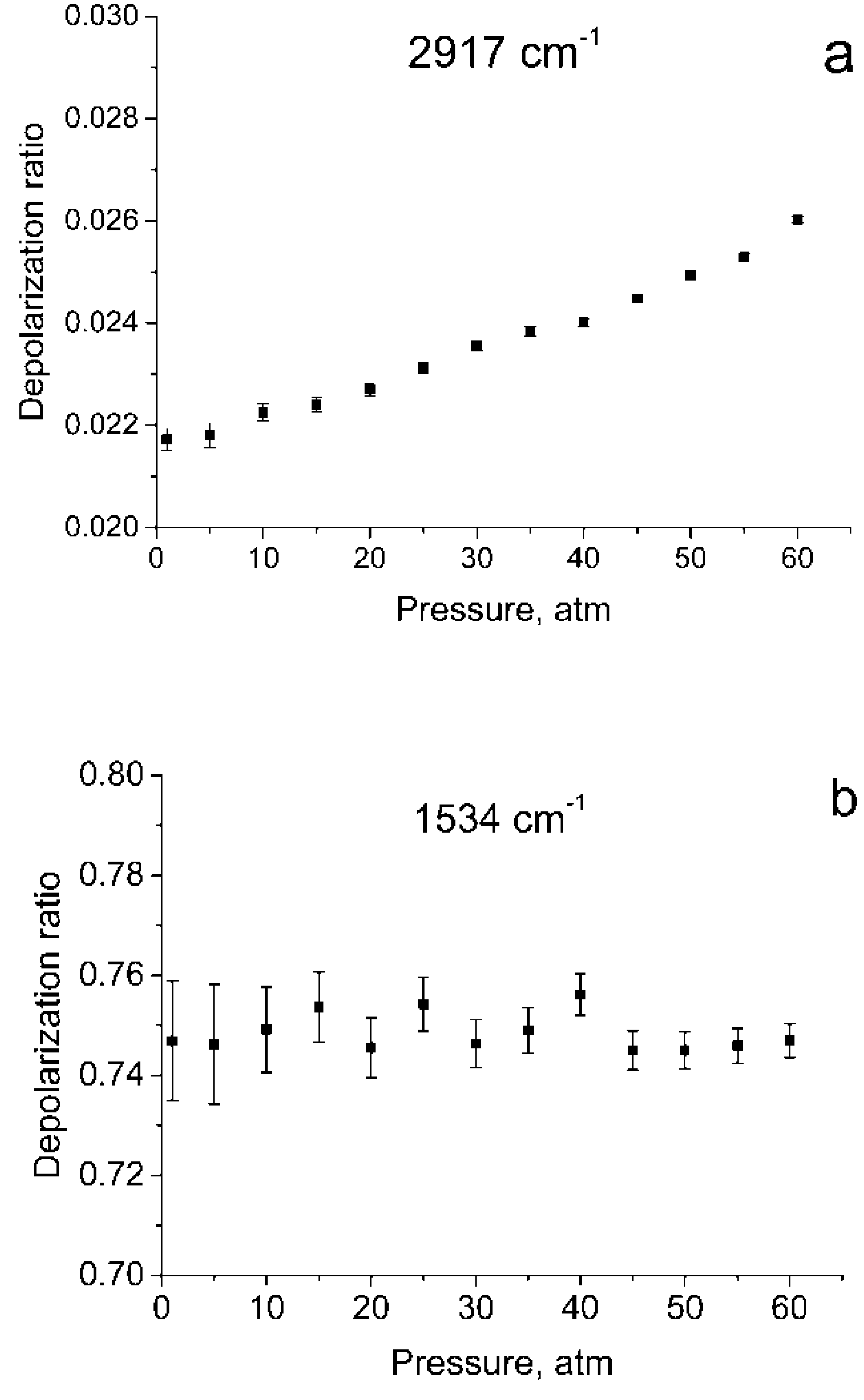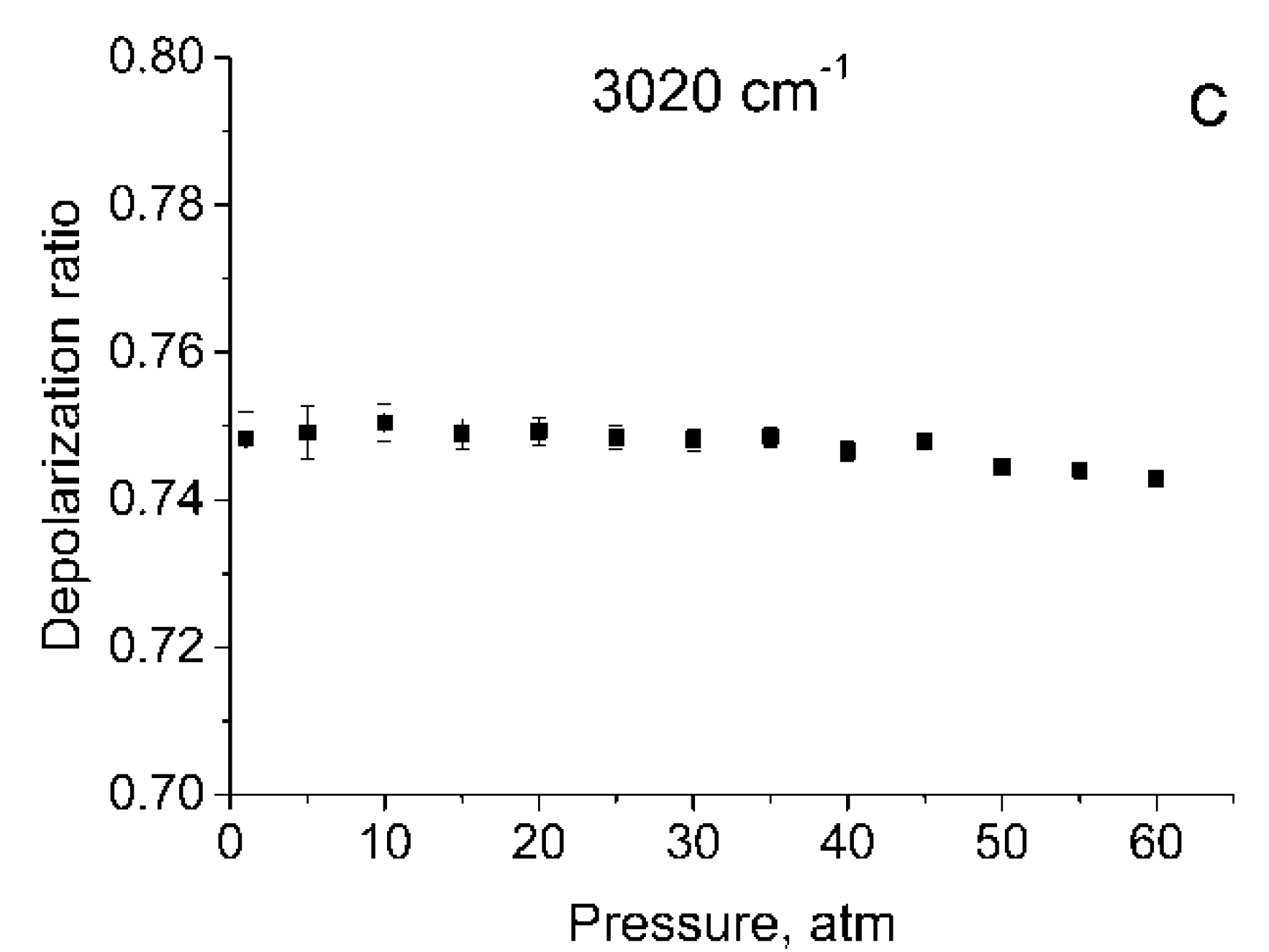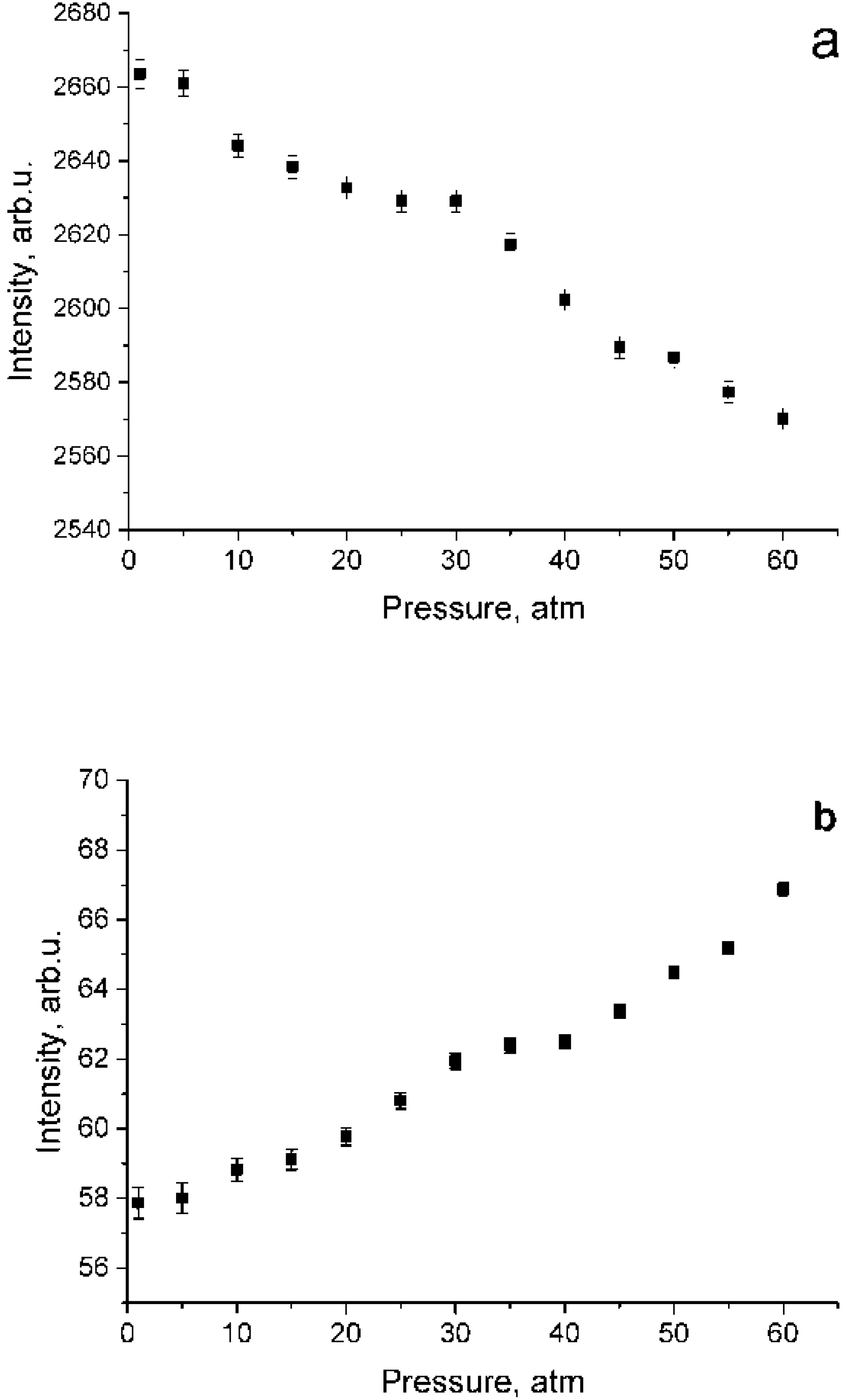Depolarization Ratios of Methane Raman Bands as a Function of Pressure
Abstract
1. Introduction
2. Experiment
3. Results and Discussion
4. Conclusions
Funding
Conflicts of Interest
References
- Petrov, D.V.; Matrosov, I.I. Raman Gas Analyzer (RGA): Natural Gas Measurements. Appl. Spectrosc. 2016, 70, 1770–1776. [Google Scholar] [CrossRef] [PubMed]
- Petrov, D.V.; Matrosov, I.I.; Tikhomirov, A.A. High-Sensitivity Spontaneous Raman Spectrometer for Gaseous Media. J. Appl. Spectrosc. 2015, 82, 120–124. [Google Scholar] [CrossRef]
- Hippler, M. Cavity-Enhanced Raman Spectroscopy of Natural Gas with Optical Feedback cw-Diode Lasers. Anal. Chem. 2015, 87, 7803–7809. [Google Scholar] [CrossRef] [PubMed]
- Sandfort, V.; Trabold, B.; Abdolvand, A.; Bolwien, C.; Russell, P.; Wöllenstein, J.; Palzer, S. Monitoring the Wobbe Index of Natural Gas Using Fiber-Enhanced Raman Spectroscopy. Sensors 2017, 17, 2714. [Google Scholar] [CrossRef] [PubMed]
- Sieburg, A.; Schneider, S.; Yan, D.; Popp, J.; Frosch, T. Monitoring of gas composition in a laboratory biogas plant using cavity enhanced Raman spectroscopy. Analyst 2018, 143, 1358–1366. [Google Scholar] [CrossRef]
- Gao, Y.; Dai, L.-K.; Zhu, H.-D.; Chen, Y.-L.; Zhou, L. Quantitative Analysis of Main Components of Natural Gas Based on Raman Spectroscopy. Chinese J. Anal. Chem. 2019, 47, 67–76. [Google Scholar] [CrossRef]
- Gomez Velez, J.; Muller, A. Trace gas sensing using diode-pumped collinearly detected spontaneous Raman scattering enhanced by a multipass cell. Opt. Lett. 2020, 45, 133. [Google Scholar] [CrossRef]
- Sharma, R.; Poonacha, S.; Bekal, A.; Vartak, S.; Weling, A.; Tilak, V.; Mitra, C. Raman analyzer for sensitive natural gas composition analysis. Opt. Eng. 2016, 55, 104103. [Google Scholar] [CrossRef]
- Dąbrowski, K.M.; Kuczyński, S.; Barbacki, J.; Włodek, T.; Smulski, R.; Nagy, S. Downhole measurements and determination of natural gas composition using Raman spectroscopy. J. Nat. Gas Sci. Eng. 2019, 65, 25–31. [Google Scholar] [CrossRef]
- Lin, F.; Bodnar, R.J.; Becker, S.P. Experimental determination of the Raman CH4 symmetric stretching (ν1) band position from 1–650 bar and 0.3–22 °C: Application to fluid inclusion studies. Geochim. Cosmochim. Acta 2007, 71, 3746–3756. [Google Scholar] [CrossRef]
- Petrov, D.V. Raman Spectrum of Methane in the Range 20–40 °C. J. Appl. Spectrosc. 2017, 84, 420–424. [Google Scholar] [CrossRef]
- Lin, F.; Sum, A.K.; Bodnar, R.J. Correlation of methane Raman ν1 band position with fluid density and interactions at the molecular level. J. Raman Spectrosc. 2007, 38, 1510–1515. [Google Scholar] [CrossRef]
- Petrov, D.V. Pressure dependence of peak positions, half widths, and peak intensities of methane Raman bands (ν2, 2ν4, ν1, ν3, and 2ν2). J. Raman Spectrosc. 2017, 48, 1426–1431. [Google Scholar] [CrossRef]
- Shang, L.; Chou, I.-M.; Burruss, R.C.; Hu, R.; Bi, X. Raman spectroscopic characterization of CH4 density over a wide range of temperature and pressure. J. Raman Spectrosc. 2014, 45, 696–702. [Google Scholar] [CrossRef]
- Petrov, D.V. Raman spectrum of methane in nitrogen, carbon dioxide, hydrogen, ethane, and propane environments. Spectrochim. Acta Part A Mol. Biomol. Spectrosc. 2018, 191, 573–578. [Google Scholar] [CrossRef]
- Wang, M.; Lu, W.; Li, L.; Qiao, S. Pressure and Temperature Dependence of the Raman Peak Intensity Ratio of Asymmetric Stretching Vibration (ν3) and Asymmetric Bending Overtone (2ν2) of Methane. Appl. Spectrosc. 2014, 68, 536–540. [Google Scholar] [CrossRef]
- Brunsgaard Hansen, S.; Berg, R.W.; Stenby, E.H. How to determine the pressure of a methane-containing gas mixture by means of two weak Raman bands, ν3 and 2ν2. J. Raman Spectrosc. 2002, 33, 160–164. [Google Scholar] [CrossRef]
- Saito, Y.; Ishibashi, T.; Hamaguchi, H. Polarization-resolved coherent anti-Stokes Raman scattering (CARS) spectroscopy: A new probe of molecular symmetry through accurate determination of the Raman depolarization ratio. J. Raman Spectrosc. 2000, 31, 725–730. [Google Scholar] [CrossRef]
- Ikawa, S.; Whalley, E. Effect of pressure on the raman depolarization ratio and the vibrational relaxation of the v1 mode of liquid carbon tetrachloride at 22°C and 0–1.1 kbar. Mol. Phys. 1992, 75, 659–667. [Google Scholar] [CrossRef]
- Thomas, M.A.; Welsh, H.L. The Raman spectrum of methane. Can. J. Phys. 1960, 38, 1291–1303. [Google Scholar] [CrossRef]
- Rose, E.J.; Whitewolf, E.; Baglin, F.G. Isothermal density tuning of the depolarization ratios from the v1 mode of methane. J. Chem. Phys. 1992, 97, 4596–4604. [Google Scholar] [CrossRef]
- Wright, M.; Murphy, T.; Baglin, F.G. Isosteric and isothermal studies of the raman depolarization ratios in an argon-methane mixture at 298 K and 323 K. Mol. Phys. 1994, 82, 277–282. [Google Scholar] [CrossRef]
- Petrov, D.V.; Matrosov, I.I.; Sedinkin, D.O.; Zaripov, A.R. Wavenumber calibration of a multichannel Raman spectrometer. Proc. SPIE 2017, 10466, 1046606. [Google Scholar]
- Lolck, J.E.; Robiette, A.G. A theoretical model for the interacting upper states of the ν1, ν3, 2ν2, ν2 + ν4, and 2ν4 bands in methane. J. Mol. Spectrosc. 1981, 88, 14–29. [Google Scholar] [CrossRef]
- Dymond, J.H.; Marsh, K.N.; Wilhoit, R.C.; Wong, K.C. Virial Coefficients of Pure Gases and Mixtures; Frenke, M., Marsh, K.N., Eds.; Springer: Berlin, Germany, 2003. [Google Scholar]
- Abbate, S.; Gussoni, M.; Zerbi, G. Raman intensities of methanes from electrooptical parameters. J. Mol. Spectrosc. 1978, 73, 415–429. [Google Scholar] [CrossRef]







© 2020 by the author. Licensee MDPI, Basel, Switzerland. This article is an open access article distributed under the terms and conditions of the Creative Commons Attribution (CC BY) license (http://creativecommons.org/licenses/by/4.0/).
Share and Cite
Petrov, D. Depolarization Ratios of Methane Raman Bands as a Function of Pressure. Molecules 2020, 25, 1951. https://doi.org/10.3390/molecules25081951
Petrov D. Depolarization Ratios of Methane Raman Bands as a Function of Pressure. Molecules. 2020; 25(8):1951. https://doi.org/10.3390/molecules25081951
Chicago/Turabian StylePetrov, Dmitry. 2020. "Depolarization Ratios of Methane Raman Bands as a Function of Pressure" Molecules 25, no. 8: 1951. https://doi.org/10.3390/molecules25081951
APA StylePetrov, D. (2020). Depolarization Ratios of Methane Raman Bands as a Function of Pressure. Molecules, 25(8), 1951. https://doi.org/10.3390/molecules25081951






